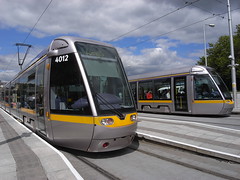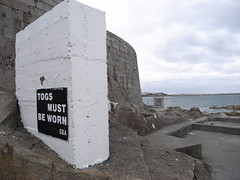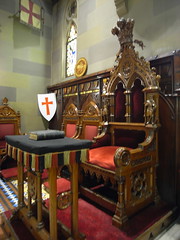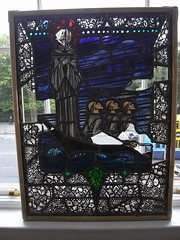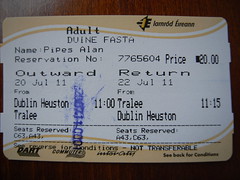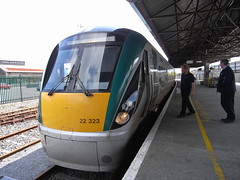No, I didn't see Funghi the dolphin (though I sort of might have seen two humpback wales) - you have to buy a boat trip out of Dingle harbour to do that. And no, I didn't get round to rereading Pete McCarthy's Bar before I set off on the train to the most Westerly extremity of Europe. There's a whole chapter on Tralee and Dingle entitled 'Blaming the dolphin' in there, which I did read when I got home. The trouble is, this wonderful book has no index or map.
The reason for my trip was outlined in Part 1; and my thoughts on Ireland's fabulous trains (and eco-tickets) has also been blogged. The journey from Dublin Heuston to Tralee, changing at Mallow, was unremarkable, save for a nifty manouvre around Killarney station. Tralee is the furthest you can go by train. You used to be able to go all the way to Dingle, and enthusiasts are trying to reopen the line, but there's nothing doing yet.
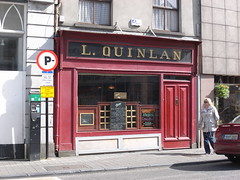
Tralee is a funny little place - why didn't they build it on the coast, just a short hop away? It has some nice old bars, notably Jess McCarthy's bar on Castle Street (there are a lot of McCarthys in Tralee) and L Quinlan's on Bridge Street (bridge? what bridge?) which has a tea room at the front and a bar, with wild west style swinging doors, at the back - with all the tables in wooden cubicles. I confess to feeling a bit nervous about little Irish Bars - you always think you might be sitting in someone's seat! Also worth seeking out is the Holy Water tap by St John's church.
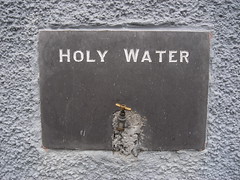
I stayed in two hotels - the big bland brown and beige business Brandon Hotel (hosting a Kerry farmers' convention the night I was there) and the more homely central Tralee Townhouse, above a TexMex restaurant. Both were fine, though at half the price, the Townhouse wins on value for money.
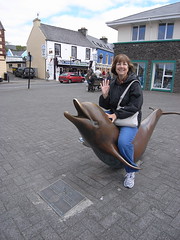
The 275 from Talee's spanking new EU-funded bus station to Dingle must rate as one of the world's most scenic bus rides, and by the wonders of wifi internet, I was met at Dingle harbour by Ross and Nancy. After a quick look around, we got in their car and headed even further west on the anticlockwise Slea Head drive. Wow, the views of Skellig and Blasket Islands were phenomenal, as we'd been blessed with perfect weather. After passing various prehistoric and famine sites, we stopped right at the tip of Slea Head, where there's a full-size white-painted crucifiction monument, and took photos in the direction of America. There was a woman with a big telescope and I asked her what she was looking at - 'humpback wales', she replied - 'look one's blowing, there's a tail'. I looked through her binoculars, but couldn't see anything except wave-lashed rocks!
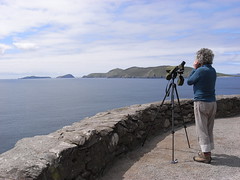
We had lunch round the north side of the peninsular, at Tig Bhric (Brick's pub), a microbrewery that did a dark ale called Cul Dorcha. I had seafood chowder, with crunchy bits of star anise thown in, and dark brown soda bread. Then it was back to Dingle and on the 5.30 luxury bus to Tralee.
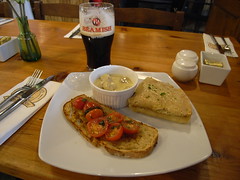
Back in Dublin, I got a 145 bus all the way from Heuston to Buswell's Hotel, right opposite the Grand Masonic Lodge. It's a splendid hotel with a beautiful lobby (though it did blot its copy book in the morning!). Then I walked to Bewley's Oriental Cafe on Grafton Street for tea and a look at the Harry Clarke stained glass windows in the back room, thence to Gallagher's Boxty House on Temple Bar for an early supper of Boxty Platter (pancake, dumplings and potato bread), and back to the Porterhouse on Nassau Street for that pint of Plain. Dublin was getting ready for a hectic Friday night, so I had a quiet Guinness (the cheapest so far) and wifi back at in the hotel lobby.
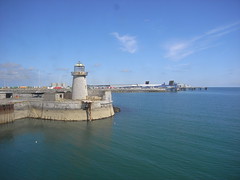
Saturday morning I had to get up at the crack of dawn to get the 8.45 ferry - so no breakfast, and only cold water in the shower! The taxi to the ferryport cost a staggering €17.20 - so it was €20 with tip - the price of a RyanAir flight to the Emerald Isle! The Jonathan Swift was on time and the weather good, so I took some photos on deck. Back in Blighty I was joined at Rhyl on a packed train (five coaches instead of ten) by Stephen 'Scandal' Randall, thanks to the miracle of mobile phone technology, so the journey back to Brighton didn't seem so long.
[More photos on Flickr]



